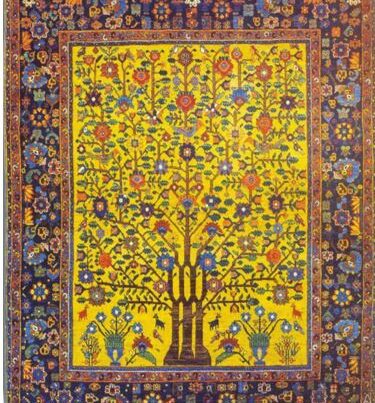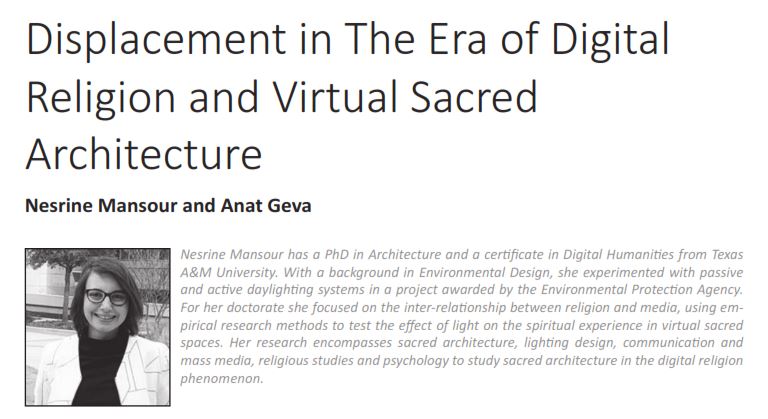

Published in 2A magazine Issue #45 – Summer 2020
Architecture is life; or at least it is life itself taking form and therefore it is the truest record of life as it was lived in the world yesterday, as it is lived today, or ever will live. So, architecture I know to be a Great Spirit. (Frank Lloyd Wright, 1939)
Today, in a world continuously shattered by displacement, the recreation of physical houses of worship that provide a spiritual relief and reaffirmation of an inner constancy becomes arduous and almost impossible. People find themselves with no place and no specific time to continue their spiritual rituals. Hence the eminent need to explore new ways to express the sacred not related to a specific physical place. This paper explores how a spiritual experience can be created in digital/virtual architecture providing a potential solution to fulfill spiritual needs in situations of displacement. Displacement and Sacred Architecture To comprehend the scope and foci of this phenomenon and its impact on spirituality, one should consider the epistemology underlying the search of immigrants for new sacred architecture. When people immigrate from their homeland, they tend to look for the familiar in their new urban or rural locations (Rapoport 1969; Upton 1987; Fitch 1990). Religious buildings are perceived to express the inter-relationship between architecture and culture through faith. Thus, houses of worship reflect immigrants collective memory and serve as a symbol of communities identity and cultural heritage. Therefore, immigrants tend to recreate places of Worship that are architecturally reminiscent of those they left behind (Fitch 1990; Geva, 1995, 2002; Dubbelde, 2006). These places when built in the new location remain fixed in place and time. Yet, in situations of displacement, which often violate a certain stability in the process of relocation, it is hard to recreate these physical places of Worship. Displacement triggers a search for different ways to experience sacredness and spirituality. A potential solution in such cases is the transformation of the real physical house of worship into virtual sacred architecture, where refugees can digitally reproduce their original buildings, or use the ones available to them in different online platforms. The recent development of new media platforms has led to digital spaces that introduce important changes in the practice of religion and resulted in the phenomenon of digital religion (Campbell, 2012; Wagner, 2012). Digital religion is a term recently used to express how digital media and spaces are forming and being shaped by religious practice (Campbell 2012). This practice is not bounded by physical constraints of place and time, as it moved within digital spaces like forums, chatrooms, virtual worlds, games, and social media (e.g. Facebook, Twitter). These virtual environments can generate evocative perceptions despite their immaterial state (Bermudez 1999). Today, digital religion manifests in several ways such as online prayers, online pilgrimages, “godcasting.” “godblogeing,” etc. (Campbell, 2010; Hill Smith, 2011). A myriad of digital techniques for online rituals vary from time-lapse interior photographs, to panoramic images of the interior of a sacred building, religious videos, live broadcasting of services (e.g. masses). interactive religious games, mobile applications, and augmented/virtual reality to name a few. Some scholars (Merleau-Ponty 1964) believe that perception of space should not be limited to the visual, tactile, and audible, but should include all the senses at once, while others (Gelfgren & Hutchings 2014) voice that virtual representations of religious buildings might facilitate a spiritual experience somehow similar to religious buildings in reality. Therefore, the virtual sacred space can create a spiritual experience that is detached from the physical fixed house of worship and can accompany worshipers on the move (Figure 1). In addition, these virtual spaces offer unlimited possibilities for architectural styles and religious features which may recreate familiar spaces for the displaced population. The question rises, can a virtually re-created sacred space provide a continuation of the spiritual experience for the displaced worshiper? First, what is spirituality? Spirituality can be seen as the continuous human yearning for something larger than the ego (Palmer 2003); or the experience of the transcendent regardless of the religious belief (Bento 2000); or the inner experience at the encounter of the beyond (Lewis and Geroy 2000). However, the common ground between religion and spirituality is posited as a search for the sacred (Zinnbauer et al, 1999), which this paper suggests can be expressed while being exposed to a virtual sacred environment. For example, websites of virtual Hindu temples where virtual pilgrimages, like Puja, are practiced contain links to meditation rooms, shrines, Puja rooms, etc. The connotation is that a click of a mouse is equivalent to physical activities performed in the physical space like walking up a path and entering a temple (Jacobs 2007). Another example represents religious virtual spaces (e.g. churches) encountered in Second Life. This game is a multi-user virtual environment that serves as the visual manifestation of spiritual imagination, where God may be encountered (Gelfgren and Hutchings 2014). It is considered a space where spirituality can be experienced. Similar to the physical space, different religious activities can take place within the delimited sacred cyberspace and generate the spiritual experience. Therefore, these virtual sacred spaces can enable the continuation of the spiritual experience from home lost to people being displaced. In order to test the theory of a continuous spirituality through digital tools, a case study follows.
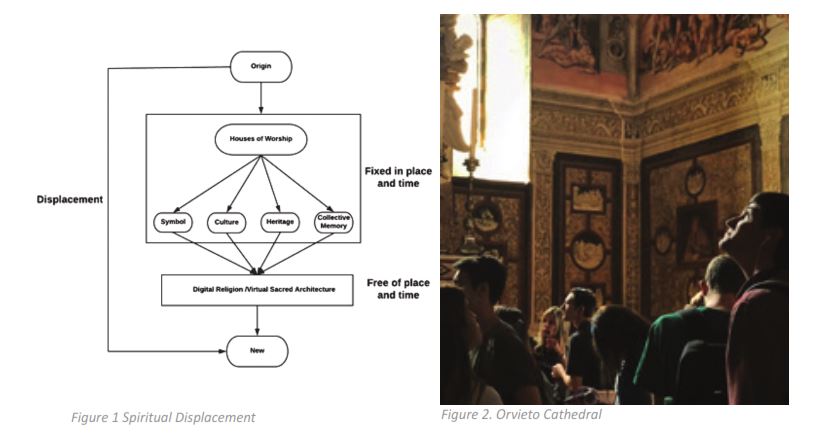
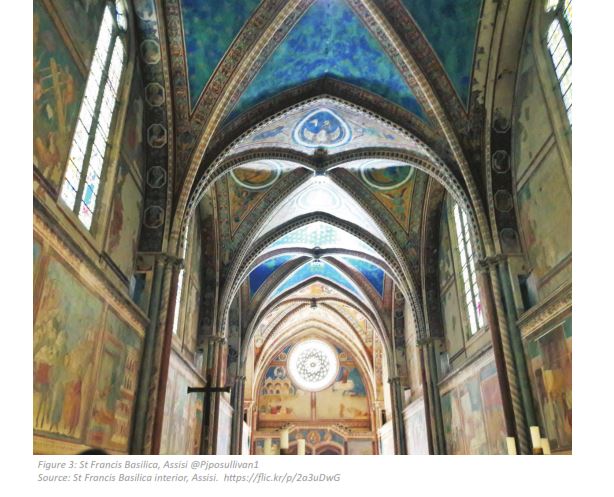
Results and Discussion The results of these experiments showed that no matter the place or time, or the real vs. the virtual, both groups expressed emotions that evoked a spiritual feeling. These results demonstrate the possibility to continue and preserve the spiritual experiences of the displaced worshipers through the virtual sacred. To supplement this conclusion, an additional experiment was conducted in a different context that highlighted the notion of no real sacred space and no specific time. This test was performed in three contexts: a visualization laboratory, a computer laboratory, and the participants’ place of choice using their personal computers. Participants were exposed to two light manipulation scenarios of the same virtual “walk-through of the church (Figures 4. 5). The results showed that no matter the context, or the light scenario, the users experienced spirituality similar to the way people visiting a real church did. Furthermore, in these cases, the positive emotions that relate to the spiritual experience, such as the feelings of awe and hope were more significant than the negative emotions such as fear, anxiety, and sadness. The conclusion drawn out from these results was that people who are displaced can still feel positive emotions and spirituality while being exposed to virtual sacred architecture. Summary and Conclusions In conclusion, displacement does not always allow the physical recreation of the sacred spaces left behind. Therefore, the virtual can bring out what was already destroyed by recreating the familiar spiritual experiences on two levels: the individual and the collective.
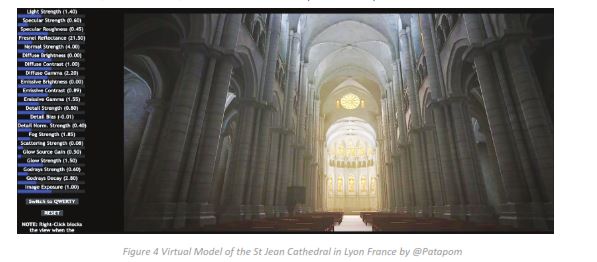

This paper shows that the move from the physical to the virtual sacred places enables the continuation of the spiritual experience. A further conclusion is that the extent of virtual spiritual experience can be measured as an emotional response, targeting emotions such as awe and hope, using assessment scales that were previously developed in psychology. The empirical results demonstrate that the spiritual phenomenon can be experienced in the digital realm, free from geographical locations and time and thus may support the need for a spiritual experience by displaced worshipers.



